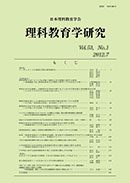Volume 52, Issue 1
Displaying 1-14 of 14 articles from this issue
- |<
- <
- 1
- >
- >|
Original Papers
-
2011 Volume 52 Issue 1 Pages 1-12
Published: July 05, 2011
Released on J-STAGE: June 30, 2021
Download PDF (1349K) -
2011 Volume 52 Issue 1 Pages 13-27
Published: July 05, 2011
Released on J-STAGE: June 30, 2021
Download PDF (26023K) -
2011 Volume 52 Issue 1 Pages 29-35
Published: July 05, 2011
Released on J-STAGE: June 30, 2021
Download PDF (3504K) -
2011 Volume 52 Issue 1 Pages 37-46
Published: July 05, 2011
Released on J-STAGE: June 30, 2021
Download PDF (4466K) -
2011 Volume 52 Issue 1 Pages 47-56
Published: July 05, 2011
Released on J-STAGE: June 30, 2021
Download PDF (1070K) -
2011 Volume 52 Issue 1 Pages 57-64
Published: July 05, 2011
Released on J-STAGE: June 30, 2021
Download PDF (6409K) -
2011 Volume 52 Issue 1 Pages 65-74
Published: July 05, 2011
Released on J-STAGE: June 30, 2021
Download PDF (1240K) -
2011 Volume 52 Issue 1 Pages 75-85
Published: July 05, 2011
Released on J-STAGE: June 30, 2021
Download PDF (1273K) -
2011 Volume 52 Issue 1 Pages 87-96
Published: July 05, 2011
Released on J-STAGE: June 30, 2021
Download PDF (1339K) -
2011 Volume 52 Issue 1 Pages 97-105
Published: July 05, 2011
Released on J-STAGE: June 30, 2021
Download PDF (1284K) -
2011 Volume 52 Issue 1 Pages 107-119
Published: July 05, 2011
Released on J-STAGE: June 30, 2021
Download PDF (1589K) -
2011 Volume 52 Issue 1 Pages 121-133
Published: July 05, 2011
Released on J-STAGE: June 30, 2021
Download PDF (3664K)
Note
-
2011 Volume 52 Issue 1 Pages 135-142
Published: July 05, 2011
Released on J-STAGE: June 30, 2021
Download PDF (956K) -
2011 Volume 52 Issue 1 Pages 143-157
Published: July 05, 2011
Released on J-STAGE: June 30, 2021
Download PDF (5156K)
- |<
- <
- 1
- >
- >|
